Are Robots Going to Replace Musicians Too?
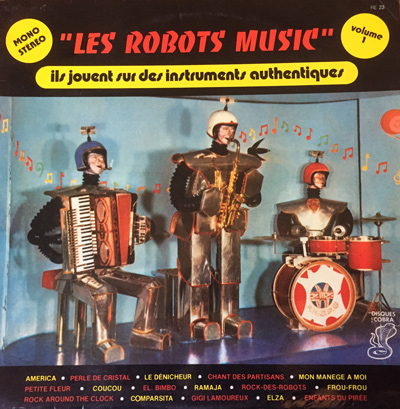
Machines are beating chess players and travel agents at their own games. Are they poised to be able to play music better than us soon?
We are on the brink of an era where machines will be driving themselves around on our streets, operating our homes and appliances, and perhaps even diagnosing and treating our illnesses as they observe us. We are told that robot aircraft will soon start delivering packages to our front doors, and our refrigerators will be ordering milk for us when they detect that we are running out. Machines have indeed been manufacturing things, counting money, playing chess and Jeopardy, picking meat out of crab bodies, and doing countless other tasks with increasing ability. So it seems inevitable that machines will also be attempting to entertain us musically on a larger scale than we've seen before, and on a level far beyond just random shuffling of our song lists, playlist management or Pandora’s streaming algorithms that try to simulate a radio DJ. So what do we have to look forward to...
"Alexa, entertain me..."
or is it going to be: "Alexa, play a Doc Watson song on your guitar."
or maybe "Alexa, show me a hologram of Harvey Reid playing the autoharp..."
Lately I have been dreaming of playing my self-tuning guitar as my self-driving car takes me to my gig. How likely is this? Will it happen to my kids? How can I be sure that my ability to walk into a room of people and deliver a song with my instruments and voice will continue to have value in the emerging Brave New World of technology that is showing all signs of being braver and newer and more revolutionary than those now-adorable steam-powered technologies of the last era of automation?
It’s been over 20 years since the last humans were pulled off the job of operating an American lighthouse, and it’s almost comical to learn about the tasks people once were paid to do, like carrying torches down paths along navigable rivers at night to guide steamboats. I remember hiring printers as recently as the 1980’s and early 90s who still used photographic darkrooms, huge cameras with hoods and lenses, razor blades, masking tape and other now-extinct graphics and printing technologies. They lovingly oiled and cleaned their A.B. Dick printing presses, and screwed the caps tightly on their brown bottles of darkroom chemicals, probably not seeing the freight train barreling down the tracks at them in the form of the little beige plastic Macintosh computers. Along with their pals the laser printer and the internet, these machines would rapidly and permanently completely transform and upend the printer and graphic designer's worlds.
As a musician staring into this digital abyss, I can imagine myself facing another series of “John Henry” experiences of man against machine, struggling to remain relevant and useful, just like truck drivers and toll booth operators today are undoubtedly wondering how long their professions will last as the robots proliferate and grow "smarter." I’ve been competing my whole life against jukeboxes, record players, radios, MTV, boom-boxes, Walkmans, iPods, DJ’s, and now YouTube, Spotify and Pandora, and I can’t help but wonder if the next wave of “clone warriors” from The Empire that I’ll need to fight might include laser holograms of singing and dancing pop artists or some other virtual reality (VR) driven, artificial intelligence (AI) enhanced or 3-D audio-visual musical experiences. These new things might mesmerize listeners in ways I couldn't possibly replicate as a guy who just plays music on an instrument as if it were the Middle Ages. Or is my very "out-of-date-ness" the key to my survival and continued relevance?
The history and proliferation of mechanical musical instruments is much larger than most of us are aware of, and the issues we face with modern machine-made music might be exactly the same ones we've been seeing all along, in new packaging. The idea of machines playing music for us is not new, and there have been mechanical musical instruments for a surprisingly long time. A look at history might offer some insight into what we now face.
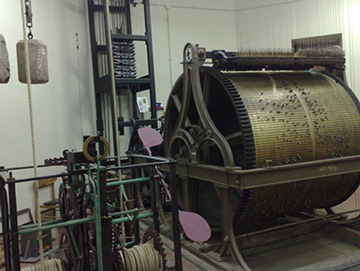
We’ve all probably marveled at the gears and springs inside a music box, which was a popular novelty that appeared in the late 1700’s, using the same kinds of technology as clock-making, that was proliferating at the time in Europe. They spread very widely, giving anyone the ability to play one song on a machine by winding a spring. In the dawn of the age of recording, John Philip Sousa himself wrote a profoundly prophetic article in 1906 called "The Menace of Mechanical Music," in which he coined the phrase “canned music.” He warned us against the dangers of a “...mechanical device to sing for us a song or play for us a piano, in substitute for human skill, intelligence, and soul.” He wondered if a mother might “… croon her baby to slumber with sweet lullabys, or will the infant be put to sleep by machinery?” He also was eerily prophetic about the idea that we might not bother to play our own music if the machines were doing it.
When I was in high school between 1969-1971, every dance we had at our school featured a live band, and a lot of those bands were startlingly good, with singers doing James Brown dance moves, 3-piece horn sections and brilliant lead guitarists. From what I can tell now, almost every school dance for a long time has featured a DJ playing recordings and not a band. There have also been cover bands in Asia for a long time that feature real humans playing near-perfect copies of popular songs by popular bands, with the musicians singing phonetically and seeming almost to be excellent robots. These two situations are not the same as robots playing instruments, but they are by-products of the same kinds of cultural forces that are mechanizing musical entertainment.
The piano and the pipe organ may have been the first mechanical musical instruments to become widespread, though they of course need a human operator who is a musician, and thus can hardly be construed as “robot” entertainment. In ancient Rome there were a number of hydraulic “automata” and “hydraulis” mechanisms that blew air through pan pipes to play melodies. I can’t tell to look at old drawings of them if they were considered a threat to the livelihood of musicians, or merely toys and minor amusements. Leo the Mathematician supposedly built an automated bird call machine in the 9th century for the Emperor Theophilos Ikonomachos, and there were a number of early clock tower machines and barrel organs in the 1400’s that appear to be descended from technology plundered from Arab sources after the fall of Constantinople in 1453. A human operator could crank one of these machines, like giant music box, and it was used to pipe music over an entire town, operated by a non-musician. A German named Athanasius Kircher, who was a DaVinci-like scholar and writer, wrote a book in Rome in 1650 called Musurgia Universalis that explained all about mechanical music of the day. (He also wrote books on Egyptology, medicine, geology, comparative religion, and all sorts of other topics. Interesting guy.) Street performers known as "organ grinders" used small barrel organs, and either turned the cranks themselves or used monkeys.
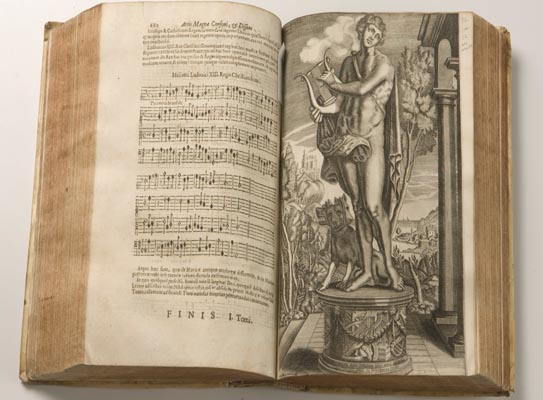
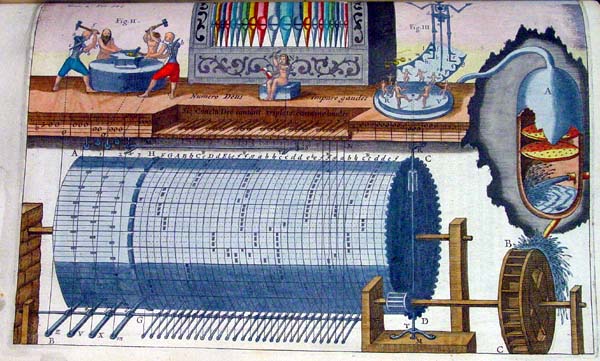
I was watching a TV show about robots with my kids, and they had footage of contests of robots that were designed by a number of research teams. My boys (age 8 and 11) were flabbergasted to see how clumsy and rudimentary the robots were, after watching so many movies and cartoons all their lives with very human-like robots that did all sorts of amazing things. One of the tests the experimental robots had to do was walk up a flight of 3 or 4 stairs, and most of them failed. They are that bad. So if they can’t even walk up the front steps of my house, how are they going to play guitar better than me?
The issue of machine-made music seems to boil down to three basic areas, if we skip over the really deep questions of "What is a machine?" and "What is music?" Let's assume we know the answer to those two questions, and just look at these:
1) machines creating music
2) human musicians collaborating with machines
3) machines playing music on their own
Machines Composing Music
The concept of electronic circuits "creating music" is questionable from a number of points of view, considering that the best robots they can make can't even climb a flight of stairs, open a door and walk into a room, and they have no emotions, concept of self, consciousness, spirituality or life experiences.
What does it mean "to create?" When a software program causes a computer to spit out a piece of music, when is it officially a "creation" and when is it even "music"? As early as 1951 researchers were trying to get early computers to create music, and there has been a steady stream of musical pieces presented to the world by computer scientists claiming some kind of creative or musical "legitimacy." The complexity of these computer/music projects is increasing, but whether any of them should be declared to be music, or whether any humans would voluntarily use the computer-generated music for anything important is another issue. A fundamental question lingers over the whole idea of computers "creating," which is the issue of who wrote the software instructions the computer follows, and how did their ideas and prejudices enter into the supposed act of "creation." I'd hate to referee a fight between opposing sides of this issue, or to be in charge of determining who gets intellectual property ownership or royalty money if the computer-generated music is sold or leased or even is used on a high-traffic web site that generated ad revenue.
I have a friend who is using computers to collect data from astronomy, biology and even weather that is converted to music, so we can essentially listen to the music of pulsars or windstorms or whatever other ideas he has of things to "listen to." Then the origins of the musical ideas and even the timing and frequencies come from the natural world, and not just from software or algorithms. The software doesn't create them, it converts them to audible frequencies, and assigns tones to them. This avoids most of the complaints many critics have of the idea of software creating musical ideas or relationships.
In 2012 there was a bit of a milestone when an orchestra of humans performed the first major symphonic piece that was written entirely by a computer, whatever that means. It was called Iamus, and it is 51 minutes long, and was recorded by the London Symphony Orchestra. You can listen or buy the album on iTunes and watch parts of it performed on YouTube, so you can form your own opinion of it. I tried listening to several movements of it, but I am not a fan or otherwise able to comment on contemporary classical music, so my inability to be captivated by it might be just evidence of my own ignorance of the genre rather than my lack of the ability to be moved by the recording of the humans playing it. I am not sure I would be wild about a lot of other modern experimental symphonic music either, even if it were created by humans. For whatever reasons, my best attempts to find anything to latch onto in Iamus yielded little in the way of enjoyment, even though to be honest I was hoping I would like something about it.
I don't think I have anything to fear from computers or apps writing music in the near future, and creating might be one of the last things the robots learn to do well.
Human Musicians Collaborating With Machines
If you think about it, there is an endless list of examples of humans and machines teaming up successfully, going back to hand tools. The lever and fulcrum don't move the rock; the saw doesn't cut the board by itself. When we drill a hole, drive a car, fly a fighter plane or operate any machine we combine our strengths with the machine's, and use our brains, senses, muscles and judgement. It's actually pretty amazing that with a couple of mirrors, a gearshift, a brake pedal, gas pedal and a steering wheel, billions of humans have managed to drive cars and trucks around for decades on all sorts of terrain and in all sorts of driving conditions without wreaking havoc. Musical instruments themselves are essentially machines with elegant interfaces that require a skilled operator. Modern musicians are also using turntables, knobs and laptops as if they were instruments.
Record players have been operated by a huge number of humans, and evolved into tape players and computer random-shuffling playlists, none of which have generally been considered to be "musical instruments" but certainly were what caused John Philip Sousa's fears and complaints in 1906. So we might want to add another bullet point, and think about whether to consider separately the situations of humans and machines collaborating to make music with either a musician or a non-musician as the human operator. Maybe the real issue is not whether a machine needs a skilled operator, but how skilled the operator needs to be to get good results, or what kinds of skills are needed. The organ grinder turning the crank of the street organ was an example from centuries ago, and perhaps the fact that they didn't destroy live music might mean that their modern incarnations won't either.
I have never much liked hearing musicians playing along with drum machines, though in the last few decades a lot of them, including some friends of mine, have done it, usually because the clubs where they were hired wanted that "bigger" sound but didn't want to pay for a drummer or deal with the loud sounds they made. Boring or annoying drum machines have been a scourge of lounge music for decades now, though some talented musicians have managed to make some great music with them. To quote a common phrase in the computer world: "Garbage in- garbage out." Good musicians can do good things with machines, but the musician who can't make magic on their own isn't likely to blossom with the addition of robot drums. J.J. Cale's first album “Naturally” (1972) comes to mind as a success story. The low-tech, simple drum machine rhythm that kicks off "Call Me the Breeze" is quickly forgotten once he and the other players get going with his hypnotic groove, cool guitar licks and gravelly vocals. The story is that he was in a hurry to make an album after Eric Clapton had some hits with his songs, and didn't have the money to hire a band.
Most pop music performances nowadays are generally put down on top of a computerized rhythm track, and even the most cynical pro-human music activist would have to admit that there have been some superb results, even if you could argue convincingly that a human drummer might have done even better. Since essentially all pop music is layered and overdubbed in the recording studio and not recorded "live," record producers argue that there is no other reasonable way to put it all together, and that you have to start with a metronomically accurate rhythm track. Any musician who has worked in the studio knows how hard it is to overdub your part on top of an unsteady rhythm track, no matter how charming it is.
I also remember rather vividly when I first went to a karaoke bar, when the first one showed up in my town back in the 1980s. My musician friends and I made a big point to show up to experience this new horror, and I was totally prepared to dislike what was going on. I quickly saw that it was just people enjoying themselves and singing songs they liked and that it was nothing to fear or hate. I just felt sorry for the singers that they didn't get to sing with a real band and had to share their passions with machines. But as long as they didn't mind, then why criticize anything about it? What band would want to back up all those crazy drunks who were bad singers?
A few years ago the first affordable consumer-market "harmony pedals" hit the market, which allowed a singer to plug their microphone cable into a small box with knobs on it, and when you sang, it would add harmony vocals to yours. My wife has one, and occasionally uses it for artistically cool things. This kind of machine was another level more complex than karaoke, because you didn't just play along with it– it was programmed to change what it did based on what you did. That made it interactive, which is typical of the current wave of machine or software-made music. You choose the key you are in, and whether you want it to sing above or below you, and some of the harmony pedals are also able to follow the chords you are playing. (You plug your guitar or piano into it as well as your vocal mike.) Somehow it does what it is supposed to do; it takes your voice, modifies it a little, and adds a harmony to the song you are singing, modifying the sound of your voice to become the harmony singer. The machine is not singing or creating; the software has been shaped so that it makes "intelligent" guesses as to what might sound good, and it is surprisingly good, but is neither perfect nor awesome. You need to learn to operate it, and work around its shortcomings. I can imagine having fun now and then with one of them, and I have watched singers demonstrate the devices at music trade shows.
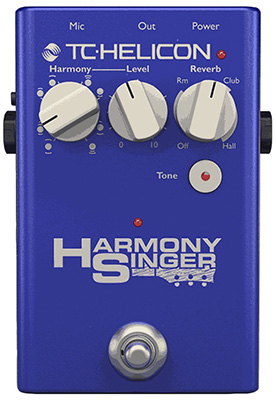
Once you accept the idea of "OK, this software is generating harmony reasonably well" a song or two later you reach the more important question of "Why is listening to this better than just listening to someone sing?" I remember going through this series of questions in my head as I beheld this device at work, and realizing that listening to someone sing with this machine was sort of like watching a person French-kissing a robot. You start wondering what the human performer is getting out of it, and why they can't or won't find a human to do it with, or why they need to do it at all. At the trade show booth, the answer was easy, because the company that was demonstrating the device wanted them to sing with it, and probably paid them. It made you wonder what that artist would do with the pedal on their own time, or when they were trying to impress or move someone with their music.
Skilled people have operated all sorts of machinery for centuries with good results, and the question here is not whether or not real beauty, real results or real art can be created by a collaboration of human and machine. It's really about what happens if we let the machines do it all.
Science fiction writers have been probing the questions for years of what might happen when the robots are given autonomy or decision-making abilities, and there may be no real answers other than that the subject is often tricky and unpredictable. The issue of self-driving cars is quickly reaching this, where we are already wondering what would happen if the car had to suddenly choose between hitting 2 different objects or people. GPS devices have done a good job of getting us to our destinations, though when they make mistakes and send us into a river or off the road we humans need to be prepared to reboot them, kick them or over-ride their intermittent errors and glitches. If they weren't top secret, we could likely learn a lot from the nuclear weapons or biological warfare installations to see how humans can oversee automated and highly dangerous things to make absolutely sure that nothing happens that shouldn't happen.
Machines Performing Music On Their Own
I have seen some pretty impressive mechanical instruments at music industry trade shows where modern electronic versions of old mechanical instruments pop up from time to time. It’s quite fun to watch the levers move as the mechanical arms pluck and bang away at whatever they’ve been built to do, but the people in the booths next to them must go nuts after hearing the same songs playing like an organ-grinder monkey for 4 days. The “player piano” captured the imagination of Americans after its invention in 1905, and enough of them were marketed and sold that the concept has become commonplace. In the late 1800’s in Europe they made entire string quartets that were hooked up by leather belts and pulleys to paper rolls that were encoded with playing instructions for the machines, and perhaps our new digital age has little to add to what we have learned already. Go find the “Encyclopedia of Mechanical Musical Instruments.”
Standard player pianos were limited not only by the fact that a paper roll had to be painstakingly loaded into it, but also because they played everything at the same volume, like a harpsichord. (Their name is sort of an oxymoron. The word piano is a shortening of the proper name of the instrument, pianoforte, which means that it can play quietly or loudly.) More sophisticated “reproducing” pianos made around 1920, such as the Welte, Ampico and the Duo-Art were downright creepy if you’ve ever been in a room with one. I was lucky enough to visit a guy who had a beautifully restored 1927 Steinway grand piano in his home with a Duo-Art mechanism built into it, which means that it was a player piano with an extra row of holes punched in the piano roll that controlled how hard the hammers struck, and thus how loud each note would be. It had 32 levels of volume, which was enough to create a “human” feeling and musical excitement that was a dramatic contrast to the sterile, dynamically flat player piano’s sound.
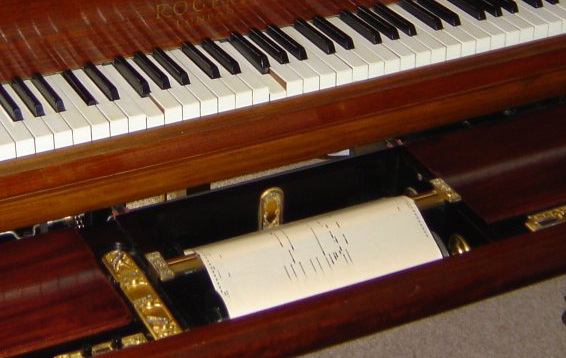
I was lucky enough to hear some piano rolls that were recorded over a century ago by Percy Grainger, Ignacy Jan Paderewski and even Scott Joplin himself. I never got to sit in a room and hear any of those people play the piano, so I can’t tell you if the emotional content of the music was there or not in the recorded version. But it sounded and felt to me like an invisible ghost was playing the instrument, since this beautiful piano was in the middle of a room playing itself. The keys were going up and down just as if invisible fingers were pressing them down, and the huge sound of that glorious instrument filled the room. I vividly remember the experience, even though it happened over 40 years ago, and I remembered thinking how amazing it was to not be listening to a paper speaker cone or technology that involved circuits and wires. The machine had mechanically captured a performance by a very skilled human, and was able to reproduce it surprisingly well. Kind of a “steampunk” robot musician, though I think there was quite a bit of editing and tinkering with the paper roll, and it didn’t just capture the performance the way we imagine.
Really good pianists of the day were apparently quite interested in the reproducing pianos. George Gershwin got his first job making piano rolls for the Aeolian company, and was able to make so much money doing it that he was able to quit school. The paper roll technology was also scorned by some because they were edited and corrected, and there were even scandals where editors put in passages that were humanly unplayable but sounded great. “Recorded performances” were edited for errors and evenness in tempo, and manufacturers began making rolls for more than 2 hands, that were not intended to capture a live performance of a great artist, but simple to amuse listeners. The reproducing pianos of the 1920’s could have offered a dramatic foreshadowing of the struggle of 21st century musicians in competing with musical automation, but they were extremely expensive and not accessible to the masses. Their popularity was also severely impacted by rapid improvements in phonograph technology and the onset of the Great Depression in 1929. Before essentially vanishing and becoming a footnote in history, they indeed set an interesting benchmark for what machines could do, and threw down a gauntlet that 100 years later still challenges computer technology to do any better.
The first widely-available modern version of the reproducing piano was the Marantz “Pianocorder,” that used cassette tapes to record and play back things on the piano. Apparently I am not the only person to be enchanted by an antique reproducing piano, and as best I can tell, it was a man named J. Herbert Orr who developed and sold a cassette-tape driven "Orrtronic Piano Play-Orr." The mechanism had a lot of bugs, and they put it into cheap pianos, so it didn't sell any better than the previous incarnations, and was sold to Sony/Marantz and later to Yamaha. The newest version is called the PianoDisc; it uses CDs, flash cards and USB drives that can either record what is played on them or play back pre-recorded performances, and even uses wi-fi now. Many of them cost $20,000 and more, so they may not catch on with the masses any better than the old ones did. Even if you don't like them as entertainment, they have value for recording studios, and make useful teaching tools, because the keys go up and down and you can see how a piece is played, at any tempo. You can also buy discs for them of performances by real artists. Pianomation is a competing technology that claims to be better. It's a vital question here as to whether or not it would be fun or moving to sit and watch a piano play itself as if a good musician were playing it. The number of places that sell these piano systems seems to indicate that a lot of people are willing to spend serious money to get one, so it is likely they were moved by hearing one, and that both systems are awesome. It's also possible that all the manufacturers and customers don't understand the difference between real music and faux-music, and it's possible that it's just a fancy music box that does not have the power that a human musician does.
I ate dinner in a restaurant where they had a PianoDisc machine that served as a cross between a jukebox and a real pianist. It “knew” a lot of songs, and you could let it randomly select things or make requests from its library. Presumably the restaurant owner thought this would be a way to have nice piano music during dinner without the hassles of hiring musicians and worrying about them drinking too much, or buying an entertainment license from the town and a performance rights license from ASCAP. I also remember that before I was halfway through my meal, I wanted to unplug the innocent-looking mechanical piano, since it put out a very annoying energy into the room that was not relaxing or soothing or whatever it was supposed to be. Maybe it was just me being fussy, or maybe that’s why we don’t see lots of these machines around pretending to entertain us. I don’t know if it was the machine itself that bothered my wife and I, or if maybe its music files were recorded by an annoying pianist. It is possible that the restaurant owner was using free "generic" music files, and that if I had heard something better, that was a recording of an actual performance by a really good pianist, I might have loved it. I have never had the chance to eat dinner and listen to a 1920’s Duo-Art piano for comparison, and when I heard one 40 years ago it was just for a few minutes. It is interesting to speculate that perhaps a century ago more primitive technology allowed something as close to a robot playing real music as the electronic versions we have now, though not so futuristic-looking.
But this issue is deep. Everybody knows that real "live" performances have a magic that can't be recreated in the studio, so why can't a pianist play the concert, but record it with a recording piano? Then the mistakes can be edited out, and the piano can be tuned again, and it can sit on the stage by itself and play the music again for a second recording session, with no audience to cough, but with the same room acoustics as the original performance. It's trivial to splice on the applause at the end, and voila, a "perfect" live performance recording. This is already happening, and recording mechanisms have been put into the best pianos in the world already. Who is going to assign labels of "right," "wrong," "brilliant" or "cheating" to this practice?
I've always comforted myself that the mechanical nature of the piano made it ideal for robotic imitation, and thought that they wouldn't be able to get a robot to play a guitar, but it has been done before and it is happening now. This band "Le Trio Robot" toured and even recorded an album in Belgium in the 1950s, using paper-rolls.
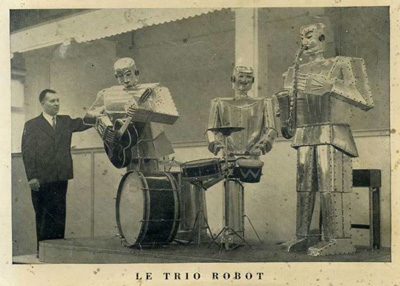
Here is a link to a current version, the German robot heavy-metal band "Compressorhead."
Robot drummers make even more sense to me than computer guitarists, since there is less nuance involved, though drummers might argue with me on that.
Conclusions...
There could be something that many people find refreshing about listening to a machine playing music, with as little human emotion as possible involved, which could be a dangerous trend if it exists, and it might accelerate the onslaught of robotic music, or at least drive a wedge into the public between those who do or don't like it. I have not studied the robot dog craze in Japan, but some people at least supposedly feel something resembling actual love for them, and some people rave about listening to a robot band. Without humans performing, listeners just hear the music itself and the tone of whatever is making the sound, and you don’t have to engage with a musician operating or interpreting it. I can believe that there might be people or businesses who prefer it, perhaps in the same vein as Muzak and “elevator music” that have existed for some time as audio wallpaper that isn’t emotional and gut-wrenching. Like buying a car at a CarMax and not dealing with annoying car salesman, or paying a toll electronically and not dealing with the pesky or bored human who takes your money. Not all music is awesome, and there are annoying musicians, and there are times when some people just want to hear the music and not have someone else’s feelings spilling all over the musical performance.
I have also seen news stories about how people are using their smartphones and tablets as pseudo musical instruments, using apps that make them feel like they are playing instruments, even though they can’t play any “real instruments.” It gives you the impression that busy modern people who don’t have time or inclination to really learn to play an instrument might find some real meaning in a watered-down digital version. Who needs a manual transmission with a gearshift and an annoying clutch when you can just put your car in Drive and step on the gas pedal when you want to move? It's possible that the interfaces of "traditional" musical instruments are too complex for modern people, and reflect the fact that people were willing to invest more time in learning to use them in the past. Simpler things may emerge that involve pushing buttons or a touch-screen instead of keys, valves, bows and strings that control the musical output. Electronic dance artists already are gyrating on stage in front of huge audiences as they manipulate turntables, laptops and tablets and twiddle knobs and levers to make the sounds.
I am reminded of a quote I came across from the 1600s by Cotton Mather, the evil Puritan witch-burning guy from Massachusetts who was also deeply involved in church music, where he once referred to organ grinders as a "box of instrumental torture." So non-musicians using machines to make mechanical music has been annoying people for centuries, which could be a good signal that it might continue to do so. Thus we may still need musicians even as the machines get more and more impressive, since the fundamental idea of a non-musician making real music by using a machine might be flawed. The machine can perhaps only "replace" a musician who is not being sufficiently human.
Obviously there is no emotional content being created in the moment when a machine plays the music, and a big question is whether or not that vital "human stuff" can be captured, bottled and passed along to the end-listener. It seemed to work well enough with the record player, which obviously passed along enough emotion to spawn a world-wide, multi-billion dollar recording industry that lasted 90 years. I remember vividly when in the 1980s some drum machine manufacturers began to develop special software that would create what they advertised as “human feel” circuitry. Presumably this meant that it would introduce random errors, and not play totally metronomically. Unfortunately, almost all pop music for the last 30 years has been built around nearly-metronomic machine drum rhythms, and though I could never stand them, it appears that hundreds of millions of music fans worldwide do love dancing and grooving to machine rhythms. Very little popular music in recent decades has been propelled by a human drummer, and that is scary to me, though it might explain why many of us don't care for much modern pop music. My dislike of non-human rhythms shouldn't make me any more hopelessly old-fashioned or "out-of-touch" than an art lover who wants to look at originals and not reproductions of great paintings.
As you might imagine, I am not going to argue for there to be more machine-made music. Quite the contrary, I hold to the hope that music will be one of the last places where skilled humans are in demand. Robots might even be able to cook meals as well as human chefs, once they learn how to select, cut up, mix and cook the ingredients, at least in certain meals that don't involve too much judgement or subtlety. The bread machine is a good example. If you just let the machine make the dough and not do the cooking, you can make some really nice bread. Its mixing, rising and kneading skills are pretty good, and the biggest shortcoming in bread machine bread is in the baking. Robots are carving guitar necks really well now too, and once they get the information loaded into them about what to do, they can do it as well as a skilled luthier. And they are consistent, and willing to make the same necks all day (or night) long without a lunch break, which is why most guitar manufacturers now use them. The robot can't make the whole guitar yet, but they do many jobs well. I've seen the robots that spray paint electric guitar bodies, and they do better than people also, and don't worry about breathing fumes.
Another thing that is fashionable these days is for researchers to stick humans inside an MRI machine and have the computer draw colored pictures of various parts of their brains lighting up as the human test subjects do various things. But I don’t think it really tells us anything really vital– in spite of giving us the feeling that we are gaining an understanding of what music really is by watching colored pictures of the brains of people who are listening to music. You may have seen discussions of how precise the hand and wrist muscle movements are when a professional baseball player hits the ball, and supposedly the player’s nervous system is doing some very impressive high-speed calculations as he swats the sinking curve ball into the outfield. But folks, this is comparatively a simple, brute-force and not-particularly-emotional or spiritual activity compared to what a skilled musician does.
Try to imagine what is going on in the nervous system, muscles and brains of someone like Stefan Grapelli, the jazz violinist, who comes to mind as a fine example of a superbly skilled, extremely human musician. Not only do musicians like him execute fine motor movements at very high speed when they take a hot solo on “Limehouse Blues,” for example, but they are shaping the volume, dynamics, pitch, tone, and vibrato of each note, and in the case of a good jazz player like Grapelli, they might be simultaneously improvising, inventing things to play, and exchanging signals and emotional energy with other members of the band and with the listeners in the audience. How is a machine, in a world where robots can barely walk up a flight of stairs, let alone dodge a coffee cup and a teddy bear as they do, going to engage in anything like playing a musical instrument with even a scintilla of the content that a skilled human can generate?
It’s my optimistic prediction as the digital storm clouds gather ominously, that after thrashing for a while, and after we have been subjected to the latest salvos in automated entertainment, the digital world and robot-crazed modernists are going to have the modern version of the old realization of how far the machines still aren’t able to go. It’s possible, and something that I can hope will increase rather than shrivel, that when more of the digital dust has settled and the novelty of digitized music’s latest incarnations has worn off, that people in large enough numbers will continue to seek out skilled musicians and revel in the subtleties and depth of what they can do. People throughout history have found great meaning, distraction, pleasure, excitement, joy and a host of other adjectives, in what other humans have brought to them musically, and hopefully the 21st century automata will not replace musicians any more than the 1st century ones did.
What I do fear is that the cost and inconvenience of having real music to listen to will go up, and the cost of machine-made music will go down while the convenience goes up, so that steadily more people won't bother to make the effort or to spend the money to get the real thing. This erosion has been steadily occurring in my lifetime, and I hope it doesn't reach a tipping point where human-made music becomes the exception rather than the rule. This sort of cost/convenience equation did serious damage to the quality of our food supply, and there are a lot of parallels between the ideas of organic, wholesome food and human-made, heart-felt music.
It seems pretty clear to me that the best thing the musicians can do at this point is to be as human as possible, and to not try to beat the machines at their own game. There might be a reason why a perfectly-played piece of music is said to be "well-executed." Let's perform and deliver our music without merely "executing" it.
This is another posting where I'm trying to raise issues, questions and awareness in the world of modern troubadours... You deserve a reward or a door prize for making it to the end. Please check back to look for new posts as I get them done. I plan to cover a wide range of issues and topics. I don't have a way for you to comment here, but I welcome your emails with your reactions. Feel free to cheer me on, or to disagree...
Chordally yours,
HARVEY REID
©2017
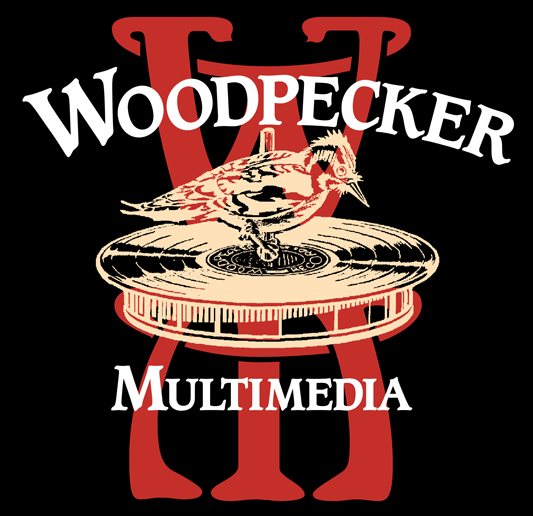 H
H 
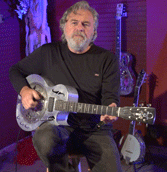

 H
H 

